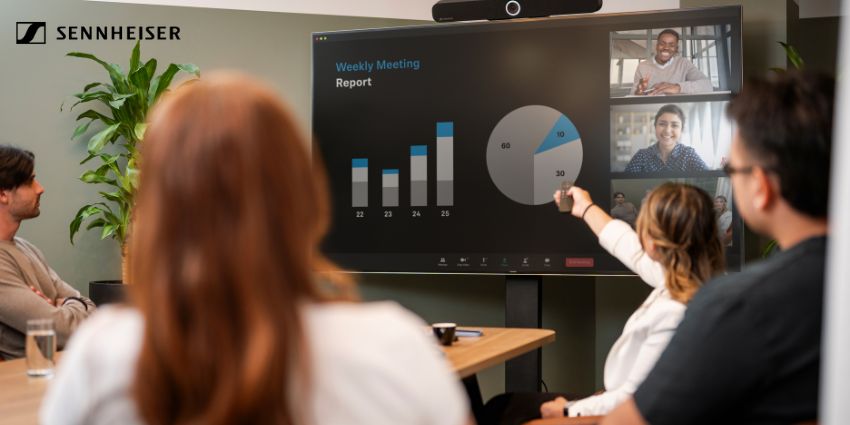As the world we live and work in continues to evolve, the tools we rely on for communication and collaboration are transforming too. In the past, the only communication endpoints that teams needed to worry about were desk phones and conferencing phones.
Now, as work becomes more diverse and mobile, we’re frequently interacting with everything from collaboration room kits to smart assistants. Heading into the years ahead, there’s no doubt that the definition of the communication endpoint will continue to change. For instance, 84% of IT managers now say that mobility is an important consideration when purchasing tech.
Although it’s impossible to predict what kind of technology we might be using in the future, we can use the current situation to imagine what’s yet to come. Here at UC Today, we decided turn to the experts and specialists in our landscape today for insights on what the years ahead might bring. We spoke to leaders from Jabra, Crestron, and Poly to bring you their thoughts on Endpoints Trends for 2021.
What are the Most Significant Customer Trends for 2020?
End customer trends play a big part in the evolution of the communication and collaboration space. Today’s vendors need to consider the changing needs of the people using endpoints to stay connected. These individuals work in an agile space, where access to the traditional desktop and office might not be available.
Currently, investment in endpoints for remote work is increasing, with 20% of meeting room budgets supporting tools that can assist companies in expanding their remote opportunities. At the same time, businesses are searching more consistently for devices that make business conversations feel just as comfortable and intuitive as personal interactions.
Joseph Sarrasin, Director of UC Strategy for Crestron:

The Director for UC Strategy at Crestron, Joseph Sarrasin, said that the most significant customer trend appearing in 2020 is the dramatic rise in UC adoption. While most companies were already moving towards this technology, COVID-19 accelerated the need for change. The adoption curve has moved from a gentle uptrend into a hockey stick.
“Up until recently, in the western world, approximately 20% of the companies were invested in UC platforms. The crisis has changed that. In the last six months, UC adoption has gone through the roof.”
Companies are recovering from COVID-19 with a new appreciation of tools that support a more flexible and agile way of working. There’s also a significant focus on the need for safety as teams return to the office. From people counting strategies to alerts when too many people are in the same space, there’s a lot to consider.
Businesses will be experimenting with everything from remote support to touchless meetings. While these things already existed, “we see that the adoption rate is picking up tremendously.”
Nigel Dunn, Managing Director EMEA North for Jabra:

Home working and remote collaboration is the biggest trend for 2020, according to Jabra’s Managing Director for EMEA North, Nigel Dunn. These trends were evident in the years leading up to 2020, but the rise of COVID-19 has forced UK workers into a new way of working faster than any of us expected. The traditional office is shrinking, and we’re replacing it with something new.
“Fortunately, this has enabled people to work anywhere at any time. Work is now more about the job you do rather than a place you go. Indeed, many feel more connected to their team than ever before.”
As the workplace scenario evolves, with a new focus on remote working and mobile access, the tools that we rely on every day are evolving too. Companies are spending more of their time and focus on solutions like Zoom and Microsoft Teams. Employees are sending fewer emails, and inboxes aren’t overflowing with attachments anymore.
Instead, we’re all working together on live collaboration documents and platforms. “This leads to an increase in efficiency, it reduces time-lags and changes the workplace dynamics into one of openness and agile teamwork.”
Tom Puorro, EVP, and General Manager at Poly:

EVP and General Manager of Poly, Tom Puorro says that rooms of ideation are a significant trend right now. Before the pandemic, companies were shifting away from larger meeting rooms to smaller huddle rooms, enhanced by video. This is a trend that may reverse going forward, with larger rooms allowing for social distancing.
“Collaboration spaces will become the star of the show in office spaces, capturing high-quality audio and video of everyone in the room in a way that makes every participant be seen, heard, and feel included. They will be increasingly equipped with native software experiences, using platforms like Microsoft Teams and Zoom, to guarantee a fluid, consumer-like experience when in use.”
Puorro also mentioned video bars becoming more intelligent, automatically tracking who’s speaking and sharing files automatically. This combined with solutions like “Bring your Own Headset,” will boost engagement for everyone. Personal communication devices that users can access everywhere will be essential in the work anywhere landscape.
Poly believes that there may be a place for enterprise-grade tech in personal workspaces too. HD video conferencing cameras, professional headsets, and other tools will become more accessible, so that employees anywhere feel heard. Resellers will see themselves managing more distributed networks of UC and AV solution due to hybrid working.
“Our SaaS offering, Poly Lens, specifically addresses this challenge by combining device management with actionable insights on endpoints and workspace usage to provide a unique view on all AV devices in use at multiple sites. Through this approach, our partners can enable customers to limit IT costs and gain the maximum value on their investment.”
What Will Be the Top Challenges Facing End Customers in 2021?
The evolution of the workplace and technology in the communication space presents a lot of powerful opportunities for businesses and vendors. However, there are challenges to consider too. As the world moves through a rapid period of transformation, many organisations will have significant threats and risks to overcome.
Failure to properly plan the right endpoint transformation could lead to issues with everything from security and compliance, to employee productivity and satisfaction. Right now, companies are under more pressure than ever to make the right choice first time around. No organisation can afford to make a mistake when it comes to equipping teams.
Joseph Sarrasin, Director of UC Strategy for Crestron:
![]() The Director of UC Strategy for Crestron, Joseph Sarrasin told us that we’re all going to be returning to the workforce – albeit at a slow pace. Although the journey back into the office is coming, the result won’t be the same working environment that many people are used to. Hybrid work environments are going to be the key to the future.
The Director of UC Strategy for Crestron, Joseph Sarrasin told us that we’re all going to be returning to the workforce – albeit at a slow pace. Although the journey back into the office is coming, the result won’t be the same working environment that many people are used to. Hybrid work environments are going to be the key to the future.
Moving forward there will be fewer cubicles and more office space supporting collaboration in an era of social distancing. “People that have to answer emails and take phone calls will be doing so from home. But if they have to collaborate, meet, or work on group projects, they will come to the office.”
It’s important to remember that human beings are inherently social creatures. We like to be around other people. We feel like we’re more involved in businesses and corporate culture when we’re in a space where we can work together. However, it won’t always be possible for every team to operate face-to-face. Social distancing and safe working is going to remain crucial for a long time.
“Technology increasing safe working environments will not be a nice to have technology, but a necessity.”
Nigel Dunn, Managing Director EMEA North for Jabra:
 Jabra’s Nigel Dunn agrees with the idea that hybrid workforces will be the way of the future. According to Nigel, staff are increasingly demanding a hybrid working model. Having the flexibility to work either at home or in the office frees employees from the grind of the pre-COVID routine.
Jabra’s Nigel Dunn agrees with the idea that hybrid workforces will be the way of the future. According to Nigel, staff are increasingly demanding a hybrid working model. Having the flexibility to work either at home or in the office frees employees from the grind of the pre-COVID routine.
According to Dunn, we’ll also see companies placing more trust in employees at all levels. Managers need to ensure that staff are productive and properly empowered. Technology plays a massive role here, and collaboration apps like Teams, as well as hardware like video collaboration solutions make it possible for people to work virtually anywhere.
“To keep the momentum going, technology needs to keep up. With new products and technologies continually coming to market, rip and replace is not always an option. There will be a need to create a hybrid environment with a balance of cloud and on-premises solutions. This needs to be done while also considering and balancing existing systems and hardware, costs of implementation, user adoption, and security concerns.”
Nigel told us that another significant challenge for this landscape will be determining whether costs can remain at an acceptable level. This will involve rolling out updates to licenses when possible, and add-ons to those purchases as they become available.
Tom Puorro, EVP, and General Manager at Poly:
 Poly and Tom Puorro said that companies everywhere are searching for ways to reimagine the workplace. The rise of hybrid working means that businesses need to invest in increased flexibility across multiple locations while prioritising outcome-based working. People need to remain connected through seamless workflows and convenient technology.
Poly and Tom Puorro said that companies everywhere are searching for ways to reimagine the workplace. The rise of hybrid working means that businesses need to invest in increased flexibility across multiple locations while prioritising outcome-based working. People need to remain connected through seamless workflows and convenient technology.
Organisations must expand their investment to create professional, consistent experiences for every team, no matter where they’re located. We’ll see an increase in enterprise set-ups for the home as this new working landscape becomes permanent for teams. This demands the latest technology, with amazing video and audio to support stronger experiences. Make-shift setups where people are shouting constantly at their laptops won’t work.
“The onus will move to the employer to provide workers with the audio and video solutions to work effectively from anywhere. It’s in the business’s interest to do so too, in order to manage the devices, ensure security and support users most effectively.”
Puorro told us that workspaces will naturally evolve as businesses embrace smaller footprints over dispersed locations, with co-working spaces appearing as part of the mix. Central offices will remain, but they may downsize for better collaboration an ideation. In these spaces, organisations will need to design environments that empowers hybrid worker productivity.
“Hardware such as videoconferencing bars that have built-in native experiences will be crucial for fast adoption for consistent experiences no matter where workers meet. This includes the ability for workers to join and share content wirelessly from their personal device.”
Which Technology Will Deliver the Most Value to Customers in 2021?
As the landscape continues to transform at an incredible rate, technology will be the key that opens the door to new opportunities for most businesses. Already, there’s plenty of evidence in the landscape of how influential the right technology can be. For instance, the 2019 ‘Impact of Video Conferencing’ Report by Lifesize, found that 41% of users believe that video conferencing tools lead to more engaged teams.
Easy-to-use and intuitive endpoints need to be available to suit all aspects of the Unified Communication landscape. The smarter and more accessible these solutions are, the more companies will see their teams benefit from more meaningful experiences. We asked our thought leaders which technology investments will be driving the most value for customers in 2021.
Joseph Sarrasin, Director of UC Strategy for Crestron:
Crestron’s Joseph Sarrasin told us that technology supporting both native experience and Bring Your Own Device possibilities is likely to be an important purchase. If you have technology that can be both native and BYOD enabled in one device, you can ensure the best experience.
Employees will be able to access native experience, and one-touch join opportunities for around 80% of the meetings that they hold through the organisation’s preferred platform. “But if you need to use a different platform, you can bring your laptop. And when you plug it in, it overrides the native platform, and your BYOD meeting running on your laptop overtakes the audio and the video in this space.”
Sarrasin went on to say that following the pandemic, BYOD is becoming more essential because it feels safer. People want to feel that they can use their own devices for hygiene and security. Additionally, we all like using our own devices out of familiarity too. We’ve been using these products for months now; it only makes sense to continue using them.
Nigel Dunn, Managing Director EMEA North for Jabra:
Jabra’s Nigel Dunn said that video platforms like Microsoft Teams and Zoom have been essential throughout 2020. These tools will continue to be a must-have throughout 2021, allowing for successful collaboration and remote working opportunities, which are here to stay going forward. Certified devices will provide value-added enhanced features for full integration and easy plug-and-play support.
According to Dunn, certified devices will make it much easier to set up and access a video call. “The beauty of certified, professional-grade devices is that they are specifically designed to help workers and increase productivity. This technology allows end-users to not be restricted to locations. As we continue to see, productivity and collaboration can happen anywhere with the right tools.”
Nigel notes that the major advantage of businesses being flexible, trusting workers, and providing quality tech is the boost in morale it can offer. However, these steps also widen the talent pool for organisations as location becomes less essential when searching for top-quality staff.
Tom Puorro, EVP, and General Manager at Poly:
Tom Puorro says that organisations need to focus on creating easy-to-use and consistent experiences for everyone in the workspace. As hybrid working becomes the new normal, the solutions available to power user-first communications will continue growing. The industry has a responsibility to keep up with the latest technological developments and use cases while reacting to demands.
The best technology and communication tools for driving productivity and collaboration, according to Puorro share certain features. These tools must be low-touch and voice-controlled. “Low-touch and voice-based technologies will limit contact with shared screens and surfaces. Meeting spaces will not require physical interaction, with user recognition, voice-based services, and smart integration capabilities, allowing workers to connect and share content wirelessly to meetings via video bars and consoles.”
The Poly Proximity Join on Microsoft certified Studio X bars are great for this zero-touch experience. Tom also notes that the best tools must offer built-in native experience. “ As employee work patterns change, the focus will be on creating spaces that are human-first and focused on empowering ideation. Video conferencing bars with built-in native software experiences (e.g., Zoom and Microsoft Teams), will play a starring role in the development of collaboration spaces in offices.”
Poly notes that the integration of cloud services into such hardware will provide a more consistent experience for workers wherever they are too.
What’s Your Prediction for the Biggest Game-Changing Trend in 2021?
2020 brought changes to the landscape that no-one could have predicted. As we look ahead to 2021, we’re all cautiously wondering what the next months might bring. For some companies, the opportunities might be in new solutions for AI and machine learning. For others, the answer to better conversations will be smarter meeting rooms.
Here’s what our industry experts believe will be the biggest game-changing trends for 2021.
Joseph Sarrasin, Director of UC Strategy for Crestron:
Joseph told us that smart rooms will be leading the way next year. As video conferencing emerges as a must-have component of every room, companies pay more attention to touchless meetings and user experiences. End users what a solution that’s cost-effective, easy to deploy, and highly scalable. This goes beyond just using UC technology and pure communication possibilities.
“Instead they want that technologies offering environmental control, room control, digital signage, people counting and motion sensors, room scheduling, and room signage are connected and integrated”
Crestron believes that these innovations will allow customers to use technology as a central hub for their smart room, rather than a simple one-dimensional device that’s only for communication.
Nigel Dunn, Managing Director EMEA North for Jabra:
Nigel Dunn told us that although companies have been discussing the potential of AI for years, it could become a true gamechanger for 2021. While this technology might not revolutionise the way we live, businesses will ramp up their usage to streamline efficiency for the organisation. We’re also going to see an increase in the rise of futureproof hardware, according to Dunn.
“SDK’s for open source platform integration to deliver value added device features with ease is now a must. The benefit of this is that hardware can be upgraded rather than having to be replaced and can be tailored and modified to be fit for purpose, so the end-user can implement the functionality they need in their hardware devices”
Digital analytics in a transformative world will also appear heavily across all sectors. This will enhance the quality of service for today’s teams, increasing efficiency and boosting productivity. Opportunities abound for both internal teams, and employees in customer-facing roles.
Tom Puorro, EVP, and General Manager at Poly:
Tom Puorro of Poly said that the biggest opportunity will be in new levels of engagement. We’re already seeing an increase of AI in video conferencing technology. This innovation will increase going forward, delivering new ways to share and collaborate.
“For example, cameras with automatic speaker tracking and split screen functionality ensure participants both in and out of the office are fully immersed in the meeting. More advanced systems can also intelligently monitor what’s happening in a meeting and within its wider environment, block out distracting sounds to ensure voices are crystal clear”
According to Puorro, companies can also expect to see voice recognition and facial recognition in video conferencing hardware. This will mean that when someone walks into a room or join a meeting, the system will recognise them automatically. These tools can then ask the participant if they want to start the meeting, with security and privacy built-in.
There’s no denying that the endpoint environment is evolving at an incredible rate. As the way we work and communicate continues to change, the tools that we rely on for these crucial connections will evolve too.







